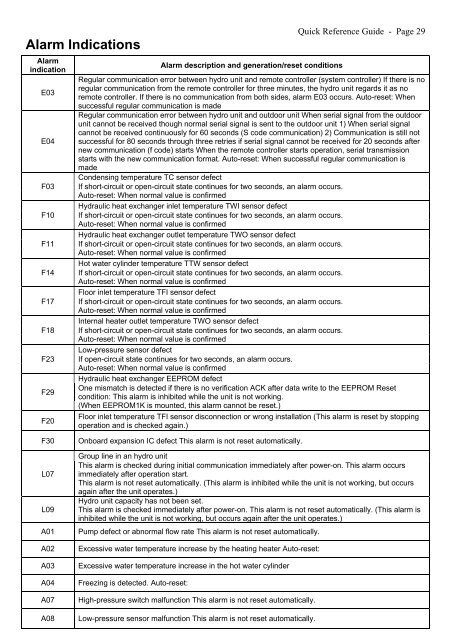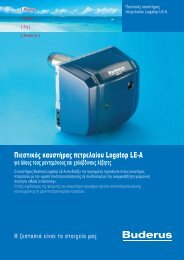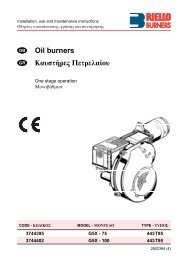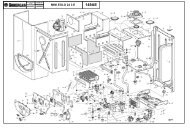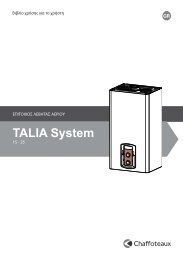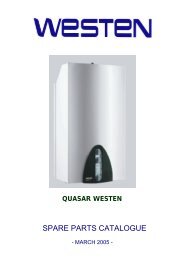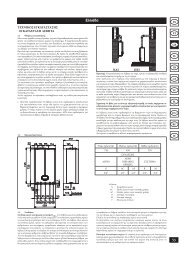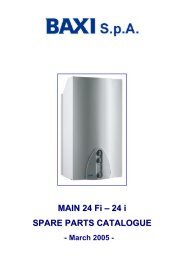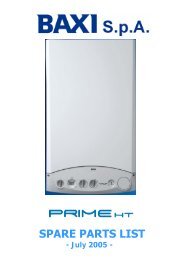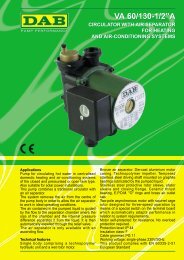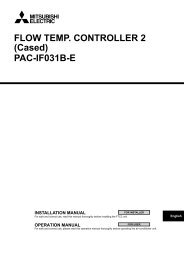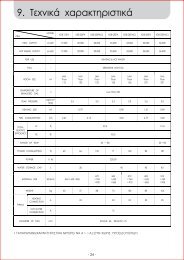You also want an ePaper? Increase the reach of your titles
YUMPU automatically turns print PDFs into web optimized ePapers that Google loves.
Alarm Indications<br />
Alarm<br />
indication<br />
E03<br />
E04<br />
F03<br />
F10<br />
F11<br />
F14<br />
F17<br />
F18<br />
F23<br />
F29<br />
F20<br />
Alarm description and generation/reset conditions<br />
Quick Reference Guide - Page 29<br />
Regular communication error between hydro unit and remote controller (system controller) If there is no<br />
regular communication from the remote controller for three minutes, the hydro unit regards it as no<br />
remote controller. If there is no communication from both sides, alarm E03 occurs. Auto-reset: When<br />
successful regular communication is made<br />
Regular communication error between hydro unit and outdoor unit When serial signal from the outdoor<br />
unit cannot be received though normal serial signal is sent to the outdoor unit 1) When serial signal<br />
cannot be received continuously for 60 seconds (S code communication) 2) Communication is still not<br />
successful for 80 seconds through three retries if serial signal cannot be received for 20 seconds after<br />
new communication (f code) starts When the remote controller starts operation, serial transmission<br />
starts with the new communication format. Auto-reset: When successful regular communication is<br />
made<br />
Condensing temperature TC sensor defect<br />
If short-circuit or open-circuit state continues for two seconds, an alarm occurs.<br />
Auto-reset: When normal value is confirmed<br />
Hydraulic heat exchanger inlet temperature TWI sensor defect<br />
If short-circuit or open-circuit state continues for two seconds, an alarm occurs.<br />
Auto-reset: When normal value is confirmed<br />
Hydraulic heat exchanger outlet temperature TWO sensor defect<br />
If short-circuit or open-circuit state continues for two seconds, an alarm occurs.<br />
Auto-reset: When normal value is confirmed<br />
Hot water cylinder temperature TTW sensor defect<br />
If short-circuit or open-circuit state continues for two seconds, an alarm occurs.<br />
Auto-reset: When normal value is confirmed<br />
Floor inlet temperature TFI sensor defect<br />
If short-circuit or open-circuit state continues for two seconds, an alarm occurs.<br />
Auto-reset: When normal value is confirmed<br />
Internal heater outlet temperature TWO sensor defect<br />
If short-circuit or open-circuit state continues for two seconds, an alarm occurs.<br />
Auto-reset: When normal value is confirmed<br />
Low-pressure sensor defect<br />
If open-circuit state continues for two seconds, an alarm occurs.<br />
Auto-reset: When normal value is confirmed<br />
Hydraulic heat exchanger EEPROM defect<br />
One mismatch is detected if there is no verification ACK after data write to the EEPROM Reset<br />
condition: This alarm is inhibited while the unit is not working.<br />
(When EEPROM1K is mounted, this alarm cannot be reset.)<br />
Floor inlet temperature TFI sensor disconnection or wrong installation (This alarm is reset by stopping<br />
operation and is checked again.)<br />
F30<br />
L07<br />
L09<br />
A01<br />
A02<br />
A03<br />
A04<br />
A07<br />
A08<br />
Onboard expansion IC defect This alarm is not reset automatically.<br />
Group line in an hydro unit<br />
This alarm is checked during initial communication immediately after power-on. This alarm occurs<br />
immediately after operation start.<br />
This alarm is not reset automatically. (This alarm is inhibited while the unit is not working, but occurs<br />
again after the unit operates.)<br />
Hydro unit capacity has not been set.<br />
This alarm is checked immediately after power-on. This alarm is not reset automatically. (This alarm is<br />
inhibited while the unit is not working, but occurs again after the unit operates.)<br />
Pump defect or abnormal flow rate This alarm is not reset automatically.<br />
Excessive water temperature increase by the heating heater Auto-reset:<br />
Excessive water temperature increase in the hot water cylinder<br />
Freezing is detected. Auto-reset:<br />
High-pressure switch malfunction This alarm is not reset automatically.<br />
Low-pressure sensor malfunction This alarm is not reset automatically.


